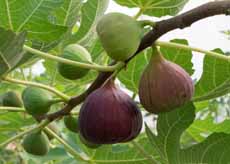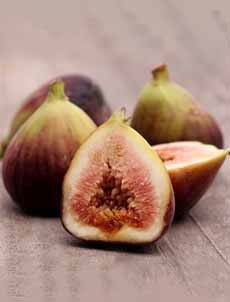FOOD 101: The World’s Oldest Foods
 [1] Figs growing on the tree (photo courtesy Indoor Citrus Trees). 
[2] Brown turkey figs (photo courtesy Melissa’s). |
For back-to-school season, we went back to “food school” to re-examine the domestication of crops.
In 2006, the discovery of figs in an 11,400-year-old house near the ancient city of Jericho established figs as the world’s oldest cultivated crop—toppling the previous contenders, wheat and barley. Who knows what evidence will be found going forward, but for now, figs wear the crown. The figs were from a type of fig tree that was not pollinated by insects. Such a parthenocarpic tree won’t reproduce unless. Human intervention is required, to grow more trees from a cuttings. Voilà: earliest known instance of agriculture, the practice of farming, which in includes cultivation of the soil for the growing of crops*. A parthenocarpic tree doesn’t produce seeds to reproduce, but a benefit is that its fruit is prevented from falling off the tree. This allows it to become soft and sweet instead of falling to the ground, often before it reaches its sweet peak. That sweeter fruit may be why man—or rather, woman—continually planted shoots from the trees. How did prehistoric woman figure that out? “It’s generally women who do the gathering in hunting-and-gathering societies,” says a Harvard anthropologist, Ofer Bar-Yosef. “And years of experience would tell them exactly how the plants behaved…” [source]. But, he notes, observation and experimentation are a very slow process, perhaps requiring experimentation by generations of women. |
|
|
Previously, domestication of figs was believed to have occurred after domestication of the eight “founder crops”: The 2005 discovery now places figs on the top of the podium of the world’s oldest domesticated crops—by roughly 1,000 years, and 5,000 years earlier than previously thought. Previously, agriculture was thought to begin after 9500 B.C.E. in the Fertile Crescent, the land in and around the Tigris and Euphrates rivers that is now include Mesopotamia, and the Levant†. It’s a Near East-centric view that doesn’t include what might have been happening in the rest of the world. Some highlights [source]: *Agriculture also includes the rearing of animals to provide food, wool and other products. †The Levant is the name given to the western Fertile Crescent, a large area in southwest Asia. Its perimeters are south of the Taurus Mountains, with the Mediterranean Sea as the western boundary, and the north Arabian Desert and Mesopotamia in the east. The historical area comprises modern-day Iraq, Israel, Jordan, Lebanon, Palestine and Syria. “Levant” is an English term that first appeared in 1497. It originally referred to the “Mediterranean lands east of Italy.” Among other popular foods, Levantine cuisine gave birth to baklava, balafel, kebabs, mezze (including tabbouleh, hummus and baba ghanoush), pita and za’atar, among other dishes that are enjoyed in the U.S. and around the world. |
||


